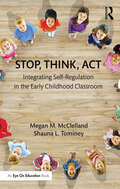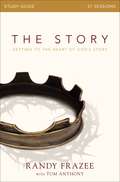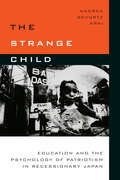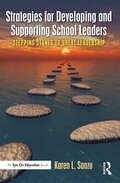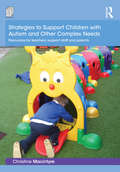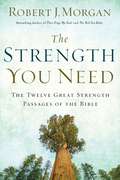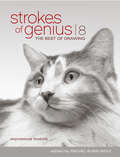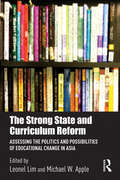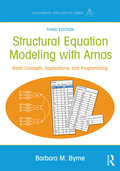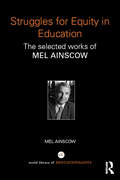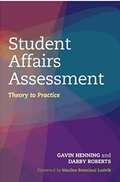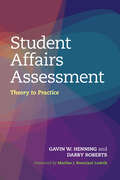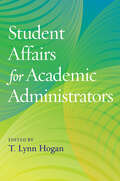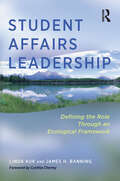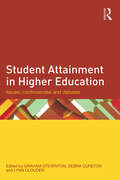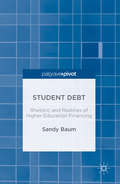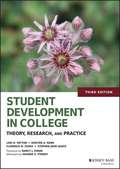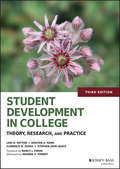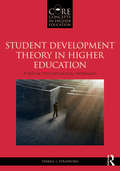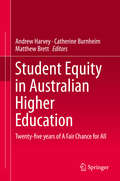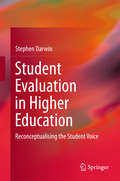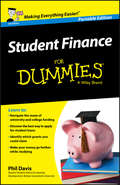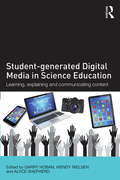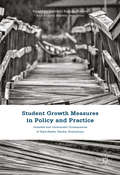- Table View
- List View
Stop, Think, Act: Integrating Self-Regulation in the Early Childhood Classroom
by Megan M. McClelland Shauna L. TomineyStop, Think, Act: Integrating Self-regulation in the Early Childhood Classroom offers early childhood teachers the latest research and a wide variety of hands-on activities to help children learn and practice self-regulation techniques. Self-regulation in early childhood leads to strong academic performance, helps students form healthy friendships, and gives them the social and emotional resources they need to face high-stress situations throughout life. The book takes you through everything you need to know about using self-regulation principles during circle time, in literacy and math instruction, and during gross motor and outdoor play. Each chapter includes a solid research base as well as practical, developmentally-appropriate games, songs, and strategies that you can easily incorporate in your own classroom. With Stop, Think, Act, you’ll be prepared to integrate self-regulation into every aspect of the school day.
The Story Study Guide: Getting to the Heart of God's Story
by Randy Frazee Tom AnthonyThe Story group Bible study provides groups of all sizes the opportunity to discuss and apply what they experience during the 31-week The Story church campaign.To understand the Bible, says Frazee, you need bifocal lenses, because two perspectives are involved. The Lower Story, our story, is actually many stories of men and women interacting with God in the daily course of life.The Upper Story is God’s story, the tale of his great, overarching purpose that puts the individual stories together like panels in one unified mural.In 31 sessions, The Story video-based group study opens your eyes to God’s master plan unfolding in the lives of the Bible’s characters and in your own life.Discover the heart of God’s Upper Story, and the joy that comes as you align your story with God’s. The Story Study Guide and DVD (sold separately) are designed for use by groups of all sizes, including small groups and Sunday school and adult education classes.Designed for use with The Story Adult Curriculum Study DVD (9780310329527) sold separately.
The Strange Child: Education and the Psychology of Patriotism in Recessionary Japan
by Andrea Gevurtz AraiThe Strange Child examines how the Japanese financial crisis of the 1990s gave rise to "the child problem," a powerful discourse of social anxiety that refocused concerns about precarious economic futures and shifting ideologies of national identity onto the young. Andrea Arai's ethnography details the different forms of social and cultural dislocation that erupted in Japan starting in the late 1990s. Arai reveals the effects of shifting educational practices; increased privatization of social services; recessionary vocabulary of self-development and independence; and the neoliberalization of patriotism. Arai argues that the child problem and the social unease out of which it emerged provided a rationale for reimagining governance in education, liberalizing the job market, and a new role for psychology in the overturning of national-cultural ideologies. The Strange Child uncovers the state of nationalism in contemporary Japan, the politics of distraction around the child, and the altered life conditions of--and alternatives created by--the recessionary generation.
Strategies for Developing and Supporting School Leaders: Stepping Stones to Great Leadership
by Karen L. SanzoStrategies for Developing and Supporting School Leaders assists personnel in school districts to deliver appropriate development and support practices for aspiring and current school leaders. This book explores a variety of research-based and best-practice processes that can be implemented in school districts to prepare leaders to meet the technical and adaptive demands of school leadership and the needs of a diverse student population. Sanzo lays out a cohesive framework of key processes and activities that range from the very simple and immediately implementable, to the more complex and nuanced. Providing both the "how," and "why," this important resource shares ideas, strategies, tools, and systems to develop effective and meaningful professional learning opportunities to help promote highly effective schools and districts.
Strategies to Support Children with Autism and Other Complex Needs: Resources for teachers, support staff and parents
by Christine MacintyreWorking with young children on the autistic spectrum and supporting them as they learn can be fascinating, challenging, often overwhelmingly difficult, but more than anything else, hugely rewarding. Strategies to Support Children with Autism and other Complex Needs bridges the gap between explaining what autism is and finding ways to interact through having a balance of play activities interspersed with more formal teaching of skills of everyday living. This highly practical text provides a bank of strategies that are specially designed to be matched to the developmental status of each child. These strategies are endorsed by academics who have monitored the children’s responses in communicating, pretending, playing, moving, and singing and describe how the children have responded positively over time. This book covers a variety of topics such as: The importance of play for enhancing learning for children with autism and other complex needs Evaluating different ways of developing communication Transferring learning from one environment to another to aid memorizing. Understanding the impact of sensory hypo and hyperactivity on children’s learning. Developing a ‘Theory of Mind’ The importance of movement, music and having fun Observation and assessment schedules are provided, along with clear and helpful evaluation forms which show staff in primary and early years settings how children on the autistic spectrum can be helped to make meaningful and encouraging progress. This text is an vital read for any practitioners working with children on the autistic spectrum or with complex learning difficulties.
The Strength You Need: The Twelve Great Strength Passages of the Bible
by Robert MorganWhy are we feeling so depleted when God has promised us strength equal to our days? Pastor Robert Morgan leads a busy life as a pastor and is also a multitasking caregiver to his disabled wife. Most days he feels exhausted, yet over time God has shown him how to build himself up when he's worn himself out. He has learned to fully embrace Psalm 84, as he moves from strength to strength. The valleys and the weaknesses are inevitable. Our task is to embrace these as we wait for God to take us to our next time of strength. After reviewing the 232 occurrences of the word strength in Scripture, Pastor Robert discovered twelve clear passages that drop anchor in God's Sea of Strength. Among the kinds of strength available to every believer are: Lifelong Strength: your strength will equal your days (Deuteronomy 33:25) Lasting Strength: they go from strength to strength (Psalm 84:5-7) Imparted Strength: the eyes of The Lord range throughout the earth to strengthen those whose hearts are fully committed to Him (2 Chronicles 16:9) Joyful Strength: the joy of The Lord is your strength (Nehemiah 8:10) Timely Strength: God is our refuge and strength (Psalm 46:1) Tranquil Strength: in quietness and trust is your strength (Isaiah 30:15) Renewed Strength: those who hope in the Lord will renew their strength (Isaiah 40:31) Recurring Strength: the Lord will strengthen your frame. You will be like a well-watered garden (Isaiah 58:11) Durable Strength: the Sovereign Lord is my strength; He makes my feet like the feet of a deer, He enables me to tread on the heights (Habakkuk 3:19) Unwavering Strength: Abraham did not waver through unbelief regarding the promise of God, but was strengthened in his faith and gave glory to God (Romans 4:20) Innermost Strength: I pray that out of His glorious riches He may strengthen you with power through His Spirit in your inner being (Ephesians 3:16) Riveting Strength: I can do all this through Him who gives me strength (Philippians 4:13)
StriveTogether: Reinventing the Local Education Ecosystem
by Allen S. Grossman Ann Lombard Noah Fishercase
Strokes Of Genius 8: Expressive Texture (Strokes of Genius: The Best of Drawing #8)
by Rachel Rubin WolfInspiration fresh from the studios of 131 master artists! A celebration of creative drawing, the Strokes of Genius series showcases standout work from today's top artists. This 8th volume focuses on how artists use texture to bring life and depth to subjects ranging from soulful portraits and expressive still lifes, to beautiful landscapes and pulsing city scenes. Texture plays an essential role in each of these drawings--capturing character, building mood, and paying homage to everyday moments that often go unnoticed. These pages serve up a tantalizing buffet of tactile impressions, from rough tree bark and silky fur to peeling paint and timeworn fabrics. Complete with fascinating, firsthand insights on the drawing techniques behind the textures, Strokes of Genius 8 offers hours of browsing and inspiration for artists and art-lovers alike. Inside you'll find:139 magnificent works in charcoal, pencil, pastel, colored pencil, scratchboard and pen+inkAn exciting range of styles and approaches, presented in subject-themed chaptersA behind-the-scenes look at the tools and methods used to evoke a wide range of natural and manmade textures
The Strong State and Curriculum Reform: Assessing the politics and possibilities of educational change in Asia (Routledge Research in Education Policy and Politics)
by Michael W. Apple Leonel LimAs Asian education systems increasingly take on a stronger presence on the global educational landscape, of special interest is an understanding of the ways in which many of these states direct their schools towards higher achievement. What is missing, however, are accounts that take seriously the particular construction of the strong, developmental state witnessed across many Asian societies, and that seek to understand the politics and possibilities of curriculum change vis a vis precisely the dominance of such a state. By engaging in analyses based on some of the best current social and cultural theories, and by illuminating the interactions among various state and non-state pedagogic agents, the chapters in this volume account for the complex post-colonial, historical and cultural consciousnesses that many Asian states and societies experience. At a time when much of the educational politics in Asia remains in a state of transition and as many of these states seek out through the curriculum new forms of social control and novel bases of political legitimacy, such a volume offers enduring insights into the real if not also always relative autonomy that schools and communities maintain in countering the hegemonic presence of strong states.
Structural Equation Modeling With AMOS: Basic Concepts, Applications, and Programming, Third Edition (Multivariate Applications Series)
by Barbara M. ByrneThis bestselling text provides a practical guide to structural equation modeling (SEM) using the Amos Graphical approach. Using clear, everyday language, the text is ideal for those with little to no exposure to either SEM or Amos. The author reviews SEM applications based on actual data taken from her own research. Each chapter "walks" readers through the steps involved (specification, estimation, evaluation, and post hoc modification) in testing a variety of SEM models. Accompanying each application is: an explanation of the issues addressed and a schematic presentation of hypothesized model structure; Amos? input and output with interpretations; use of the Amos toolbar icons and pull-down menus; and data upon which the model application was based, together with updated references pertinent to the SEM model? tested. Thoroughly updated throughout, the new edition features: All new screen shots featuring Amos Version 23.?? Descriptions and illustrations of Amos’ new Tables View format which enables the specification of a structural model in spreadsheet form.???? Key concepts and/or techniques that introduce each chapter. Alternative approaches to model analyses when enabled by Amos thereby allowing users to determine the method best suited to their data.? Provides analysis of the same model based on continuous and categorical data (Ch. 5) thereby enabling readers to observe two ways of specifying and testing the same model as well as compare results. All applications based on the Amos graphical mode interface accompanied by more "how to" coverage of graphical techniques unique to Amos. More explanation of key procedures and analyses that address questions posed by readers All application data files are available at www.routledge.com/9781138797031. The two introductory chapters in Section 1 review the fundamental concepts of SEM methodology and a general overview of the Amos program. Section 2 provides single-group analyses applications including two first-order confirmatory factor analytic (CFA) models, one second-order CFA model, and one full latent variable model. Section 3 presents multiple-group analyses applications with two rooted in the analysis of covariance structures and one in the analysis of mean and covariance structures. Two models that are increasingly popular with SEM practitioners, construct validity and testing change over time using the latent growth curve, are presented in Section 4. The book concludes with a review of the use of bootstrapping to address non-normal data and a review of missing (or incomplete) data in Section 5. An ideal supplement for graduate level courses in psychology, education, business, and social and health sciences that cover the fundamentals of SEM with a focus on Amos, this practical text continues to be a favorite of both researchers and practitioners. A prerequisite of basic statistics through regression analysis is recommended but no exposure to either SEM or Amos is required.
Struggles for Equity in Education: The selected works of Mel Ainscow
by Mel AinscowIn the World Library of Educationalists series, international experts compile career-long collections of what they judge to be their finest pieces – extracts from books, key articles, salient research findings, major theoretical and practical contributions – so the world can read them in a single manageable volume. Readers will be able to follow the themes and strands and see how their work contributes to the development of the field. Spanning Mel Ainscow’s accomplished 30 year international career in education, the texts in this book trace his efforts to find ways of fostering more equitable forms of education. This has involved a series of struggles as he has experimented with different approaches - in a variety of contexts - to find new possibilities for responding to learner diversity. Over the years this has related to a variety of headline themes, starting from special education, through to integration, on to inclusive education, and then, more recently, educational equity. The readings have been chosen to illustrate the changes that have occurred in Ainscow’s thinking and practices and a short introduction is provided for each chapter that is intended to help readers to understand the significance of what is presented and how this relates to other chapters in the book. The writings in this text reinforce the idea that the promotion of equity in schools is essentially a social process that has to occur within particular contexts.
Student Affairs Assessment: Theory To Practice
by Gavin W. Henning Darby Roberts Marilee Bresciani LudvikWith the recognition of the integral role of student affairs in student education, and with stakeholders requiring increasing accountability at a time of tight resources, it has become imperative that staff be familiar with and competent in undertaking assessment. This book provides student affairs staff with the grounding they need to integrate assessment into how they design and monitor the programs, services, and activities they create to contribute to students’ development. This book is intended both as a text for student affairs and higher education master’s programs, and as a practical guide for early career staff who have had little formal preparation in assessment. It can be used for self-study or in professional development workshops. For divisions, departments, or units getting started with assessment, the discussion questions at the end of the chapters can engage staff in the process of developing an effective assessment culture. This book provides a thorough introduction to all aspects of assessment, assuming no prior knowledge, and illustrated throughout with examples of application in student affairs settings. Key elements include: •Takes into account the latest standards and competencies defined by AAC&U, ACPA, AER, CAS, NASPA, and others •Introductory and comprehensive •Provides essential background and theory •Covers preparation, planning and design •Describes the full range of assessment methods •Introduces principles and methods of qualitative and quantitative analysis •Guidance on using and sharing results •Addresses cultivating and sustaining a culture of assessment •Considers ethical and political concerns •Covers use of technology •Illustrated throughout by examples of practice in student affairs.
Student Affairs Assessment: Theory to Practice
by Gavin W. Henning Darby RobertsWith the recognition of the integral role of student affairs in student education, and with stakeholders requiring increasing accountability at a time of tight resources, it has become imperative that staff be familiar with and competent in undertaking assessment. This book provides student affairs staff with the grounding they need to integrate assessment into how they design and monitor the programs, services, and activities they create to contribute to students’ development.This book is intended both as a text for student affairs and higher education master’s programs, and as a practical guide for early career staff who have had little formal preparation in assessment. It can be used for self-study or in professional development workshops. For divisions, departments, or units getting started with assessment, the discussion questions at the end of the chapters can engage staff in the process of developing an effective assessment culture. This book provides a thorough introduction to all aspects of assessment, assuming no prior knowledge, and illustrated throughout with examples of application in student affairs settings. Key elements include:• Takes into account the latest standards and competencies defined by AAC&U, ACPA, AER, CAS, NASPA, and others• Introductory and comprehensive• Provides essential background and theory• Covers preparation, planning and design• Describes the full range of assessment methods• Introduces principles and methods of qualitative and quantitative analysis• Guidance on using and sharing results• Addresses cultivating and sustaining a culture of assessment• Considers ethical and political concerns• Covers use of technology• Illustrated throughout by examples of practice in student affairs.
Student Affairs for Academic Administrators (An ACPA Co-Publication)
by T. Lynn HoganCo-published with In these days when every college or university needs to make the best use of resources, Student Affairs for Academic Administrators is intended to help academic administrators make the best use of one vital campus resource: student affairs. By providing this concise introduction to student affairs as a discipline and a profession, the authors of this volume provide a foundation for working together to improve the student experience and enhance learning. Since academic administrators typically come up through the faculty ranks, they are unlikely to have a good grasp of what their student affairs colleagues bring to the common work of education. To provide a better understanding, the chapters in this volume cover topics such as: • The history of student affairs, and functions typically associated with student affairs divisions; • Current thinking and research in student development theory; • Theoretical constructs underlying contemporary student affairs practice (and ways to employ these theories in academic administration); • Diversity issues and their impact on student outcomes in the collegiate environment.After a chapter on how to build successful collaborations between academic affairs and student affairs, two final chapters explore specific examples of how such collaborations work in practice: Academic honor codes, and undergraduate research. While written for academic administrators, the book also provides valuable insights for those in student affairs seeking to improve understanding and facilitate collaboration with colleagues in academic affairs.
Student Affairs Leadership: Defining the Role Through an Ecological Framework
by Linda Kuk James H. BanningKuk and Banning offer readers a new lens for viewing leadership, one that goes beyond a focus on the behavior and values of leaders as individuals to examine how positional leaders interact with their environments to engage in leadership “in context”. This book is addressed to aspiring and senior student affairs officers and offers a new “ecological” framework that recognizes that today’s leaders are affected by factors they may not control, and work within an environment they cannot expect to mold solely through their execution of skills and strategies.Based on research supported through a grant from the National Association of Student Personnel Administrators (NASPA) Foundation, this book explores leadership as an interactive process within varied environmental contexts, and through an analysis of the transactional process between the leader, the organizational members and the various components of the organizations environment.It describes how leaders deploy differing competencies, skills and strategies in varied contexts, and how they choose to use past experiences, their training and personal characteristics to set priorities and navigate the cultural, social, physical, legal and political, resource, and ethical environments of their organizations.Several chapters conclude with an account of how the experiences of the SSAO participants in the research informed their practice of leadership and understanding of how leadership actually works.
Student Attainment in Higher Education: Issues, controversies and debates
by Graham Steventon Debra Cureton Lynn ClouderStudent Attainment in Higher Education: Issues, controversies and debates is a timely exploration of student attainment in a rapidly changing higher education context and a rapidly changing world. The effects of neoliberalism and the commercialization of everyday life on education have been well documented, but with a focus on pedagogy, whilst student success is measured through grades, statistics and metrics. By exploring attainment in a broader context, this book provides a unique contribution to the critical literature on contemporary higher education. Within the themes of understanding attainment and challenging practice, the book sets out to explore student attainment as complex and multifaceted. It achieves this by looking at different conceptualizations of what attainment means and to whom; how attainment is shaped by different and often competing agendas and vested interests. The book highlights these wider issues, controversies and debates that underpin student attainment, whilst at the same time engaging with strategic and local interventions, which set out to improve aspects of the higher education system and increase individual and social agency within it. Sharing a range of pedagogical approaches and interventions, some of the key topics include: addressing attainment gaps engaging mature learners nurturing the intellectual identity the impact of activity choices. Creating a dialogue amongst different audiences about national and international controversies and debates around the topic of student attainment, this contribution will be beneficial to teaching professionals, policymakers and strategists. As an edited collection with contextualisation in the wider research arena, the book has both national and international applicability and transferability.
Student Debt
by Sandy BaumThis book analyzes reliable evidence to tell the true story of student debt in America. One of the nation's foremost experts on college finance, Sandy Baum exposes how misleading the widely accepted narrative on student debt is. Baum combines data, research, and analysis to show how the current discourse obscures serious problems, risks misdirecting taxpayer dollars, and could deprive too many Americans of the educational opportunities they deserve. This book and its policy recommendations provide the basis for a new and more constructive national agenda to make paying for college more manageable.
Student Development in College: Theory, Research, and Practice (Third Edition)
by Lori D. Patton Kristen A. Renn Florence M. Guido Stephen John QuayeTHE ESSENTIAL STUDENT DEVELOPMENT REFERENCE, UPDATED WITH CUTTING-EDGE THEORY AND PRACTICE<p><p> Student Development in College is the go-to resource for student affairs, and is considered a key reference for those most committed to conscious and intentional student affairs practice. This third edition includes new chapters on social class, disability, and emerging identity theories, with expanded coverage of faith and gender identity. A new framework provides guidance for facilitating dialogues about theory, teaching theory, and the importance of educators as consumers of theory. Discussion questions conclude each chapter and vignettes are woven throughout to provide practical context for theory. Learning activities in the appendix promote comprehension and application of theory.
Student Development in College: Theory, Research, and Practice
by Lori D. Patton Kristen A. Renn Florence M. Guido Stephen John QuayeTHE ESSENTIAL STUDENT DEVELOPMENT REFERENCE, UPDATED WITH CUTTING-EDGE THEORY AND PRACTICE Student Development in College is the go-to resource for student affairs, and is considered a key reference for those most committed to conscious and intentional student affairs practice. This third edition includes new chapters on social class, disability, and emerging identity theories, with expanded coverage of faith and gender identity. A new framework provides guidance for facilitating dialogues about theory, teaching theory, and the importance of educators as consumers of theory. Discussion questions conclude each chapter and vignettes are woven throughout to provide practical context for theory. Learning activities in the appendix promote comprehension and application of theory. Get updated on the latest in student development theory and application Consider both the psychosocial and cognitive aspects of identity Learn strategies for difficult dialogues, and the importance of reflection Adopt an integrated, holistic approach to complex student development issues Student Development in College is the ideal resource for today's multifaceted student affairs role. "With five new or expanded chapters and critical updates throughout the text, this third edition expertly presents the complex, multifaceted, and continually evolving nature of the theories that inform scholars and professionals in their research and practice with college students. These authors, consummately aware of the needs of emerging and continuing student affairs professionals, have crafted a text that will be both eminently practical and intellectually engaging for graduate students, professionals, and faculty alike." —Dafina-Lazarus Stewart, associate professor, higher education and student affairs, Bowling Green State University "This third edition of Student Development in College beautifully presents the theoretical terrain of student development by honoring the foundational theories upon which the field was developed and foregrounding newer theories with brand new content and fresh perspectives. The result is a text that is comprehensive, sophisticated, and accessible—and one that is attuned to the contemporary realities of the complexities of student development." —Susan R. Jones, professor, higher education and student affairs, The Ohio State University
Student Development Theory in Higher Education: A Social Psychological Approach (Core Concepts in Higher Education)
by Terrell L. StrayhornMoving beyond the theories traditionally used to describe college student development, this engaging book introduces social psychological theories that address the most relevant issues in higher education today. Covering theories of ecological systems, sense of belonging, prejudice and discrimination, positive psychology, social capital, personality theory, mentoring, and hope theory, this book promotes the understanding and application of social psychological theories to various higher education contexts. Examples from diverse student populations encourage learners’ application to situations in their own contexts. Comprehensive enough to be used as a main text but accessible enough to be used alongside another, this important textbook bridges research, theory, and practice to help practicing and aspiring higher education and student affairs professionals effectively work with college students.<P><P> Special Features Include:<P> • Reflective exercises that combine theory and practice and help students apply their knowledge solving problems.<P> • Case studies and scenarios for further connections to the reader’s university and college settings.<P> • Guiding questions that encourage students to think beyond the current literature and practice.<P> • List of further readings and references for readers to explore topics in more depth.<P>
Student Equity in Australian Higher Education
by Andrew Harvey Catherine Burnheim Matthew BrettThis book examines twenty-five years of the Australian framework for student equity in higher education, A Fair Chance for All. Divided into two sections, the book reflects on the legacy of equity policy in higher education, the effectiveness of current approaches, and the likely challenges facing future policymakers. The first section explores the creation of the framework, including the major elements of the policy, the political context of its development, and how it compares with international models developed during the same period. The performance of the six student equity groups identified within the framework is also examined. The second section of the book considers future trends and challenges. The Australian university sector has undergone seismic change in the past twenty-five years and faces further changes of equal magnitude. The twenty-fifth anniversary of A Fair Chance for All comes as Australian higher education is poised for another wave of transformation, with rising expansion, competition, and stratification. While the emerging landscape is new, the questions have changed little since A Fair Chance for All was first conceived: How should we define student equity, and what policies are likely to promote it?
Student Evaluation in Higher Education
by Stephen DarwinThis book provides a comprehensive and engaging analysis of the purpose and function of student evaluation in higher education. It explores its foundations and the emerging functions, as well as its future potential to improve the quality of university teaching and student learning. The book systematically assesses the core assumptions underpinning the design of student evaluation models as a tool to improve the quality of teaching. It also analyses the emerging influence of student opinion as a key metric and a powerful proxy for assuring the quality of teachers, teaching and courses in universities. Using the voices of teachers in the day-to-day practices of higher education, the book also explores the actual perceptions held by academics about student evaluation. It offers the first real attempt to critically analyse the developing influence of student evaluation on contemporary approaches to academic teaching. Using a practice-based perspective and the powerful explanatory potential of cultural historical activity theory (CHAT), the implications of the changing focus in the use of the student voice - from development to measurement - are systematically explored and assessed. Importantly, using the evidence provided by a unique series of practice-based case studies, the book also offers powerful new insights into how the student voice can be reconceptualised to more effectively improve the quality of teaching, curriculum and assessment. Based on this empirical analysis, a series of practical strategies are proposed to enhance the work of student evaluation in the future university to drive pedagogical innovation. This unique volume provides those interested in student evaluation with a more complex understanding of the development, contemporary function and future potential of the student voice. It also demonstrates how the student voice - in combination with professional dialogue - can be used to encourage more powerful and substantial forms of pedagogical improvement and academic development in higher education environments.
Student Finance For Dummies - UK
by Phil DavisYour guide to financing a university education Navigating the intricacies of financing a UK education can make even the most composed parents and students lose their cool. Luckily, Student Financing For Dummies helps take some of the pain out of the struggle and offers everything you need—in one place—to put a money management plan in place and finance a university education. Packed with accessible guidance from authors throughout the UK who work with students and policy experts, it provides unique, sound and detailed financial advice to help students and their families manage money while at school. Taking the guesswork out of the student-finance process and saving you countless hours of searching on the Internet, this friendly, plain-English guide helps you navigate applying for student finance, student loans and grants, makes sense of subject-specific income like the NHS, Teacher Training and Social Work and more. And after the money is in place, you'll discover how to establish a financial plan to make sure the money lasts—from term to term and through the entire time at uni. Covers student finance in England, Wales, Scotland and Northern Ireland Provides all the options for obtaining finance, loans and more Gives students and parents tips on which credit options to watch out for Offers expert advice on ongoing student finance support, managing income and expenditure and working during study Take the worry out of financing your education and focus on your studies with the help of Student Finance For Dummies.
Student-generated Digital Media in Science Education: Learning, explaining and communicating content
by Garry Hoban Wendy Nielsen Alyce Shepherd"This timely and innovative book encourages us to ‘flip the classroom’ and empower our students to become content creators. Through creating digital media, they will not only improve their communication skills, but also gain a deeper understanding of core scientific concepts. This book will inspire science academics and science teacher educators to design learning experiences that allow students to take control of their own learning, to generate media that will stimulate them to engage with, learn about, and become effective communicators of science." Professors Susan Jones and Brian F. Yates, Australian Learning and Teaching Council Discipline Scholars for Science "Represents a giant leap forward in our understanding of how digital media can enrich not only the learning of science but also the professional learning of science teachers." Professor Tom Russell, Queen’s University, Ontario, Canada "This excellent edited collection brings together authors at the forefront of promoting media creation in science by children and young people. New media of all kinds are the most culturally significant forms in the lives of learners and the work in this book shows how they can move between home and school and provide new contexts for learning as well as an understanding of key concepts." Dr John Potter, London Knowledge Lab, Dept. of Culture, Communication and Media, University College London, UK Student-generated Digital Media in Science Education supports secondary school teachers, lecturers in universities and teacher educators in improving engagement and understanding in science by helping students unleash their enthusiasm for creating media within the science classroom. Written by pioneers who have been developing their ideas in students’ media making over the last 10 years, it provides a theoretical background, case studies, and a wide range of assignments and assessment tasks designed to address the vital issue of disengagement amongst science learners. It showcases opportunities for learners to use the tools that they already own to design, make and explain science content with five digital media forms that build upon each other— podcasts, digital stories, slowmation, video and blended media. Each chapter provides advice for implementation and evidence of engagement as learners use digital tools to learn science content, develop communication skills, and create science explanations. A student team’s music video animation of the Krebs cycle, a podcast on chemical reactions presented as commentary on a boxing match, a wiki page on an entry in the periodic table of elements, and an animation on vitamin D deficiency among hijab-wearing Muslim women are just some of the imaginative assignments demonstrated. Student-generated Digital Media in Science Education illuminates innovative ways to engage science learners with science content using contemporary digital technologies. It is a must-read text for all educators keen to effectively convey the excitement and wonder of science in the 21st century.
Student Growth Measures in Policy and Practice
by Audrey Amrein-Beardsley Kimberly Kappler HewittThis book examines the intersection of policy and practice in the use of student growth measures (SGMs) for high-stakes purposes as per such educator evaluation systems. The book also focuses on examinations of educators' perceptions of and reactions to the use of SGMs; ethical implications pertaining to the use of SGMs; contextual challenges when implementing SGMs; and legal implications of SGM use. The use of student test score data has been the cornerstone of the recent transfiguration of educator evaluation systems in forty-two states and the District of Columbia. Three leading voices on SGMs--Sean Corcoran, Henry Braun, and David Berliner--also serve as section and concluding commentators.
